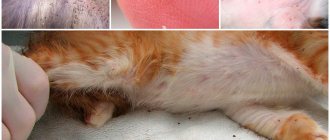At what age is gender determined?
Differences in the anatomical structure of kittens of different sexes exist and can be determined from birth. The main helpers in determining the gender of a small pet are:
- Age of the kitten: the older the baby, the easier it is to determine the gender.
- The person conducting the examination has experience with kittens.
- The ability to compare the anatomical features of several kittens.
Sexual characteristics of newborn kittens
A veterinarian or an experienced breeder who delivers several cat births annually accurately determines the gender of each kitten immediately after its birth. Of course, in newborn kittens there are only anatomical differences.
It’s easy to use knowledge of how professionals distinguish them if:
- you are observant;
- have good eyesight;
- your beloved kitty has given you a sufficient number of kittens, among which, with a high degree of probability, there are both seals and female cats - for comparison.
The appearance of the reproductive organs of a newborn cat has characteristic features:
- The openings of the “causal places” have the shape of a colon.
- The distance between the anus and the penis is 1-1.5 cm (possibly more if we are talking about kittens of large breeds).
- If you look closely, you can see the scrotum.
Anatomical details of the corresponding organs of newborn cats:
- The appearance of the anal opening and loop (vulva) is similar to a semicolon or the letter i.
- The distance between the holes is 0.5-0.7 cm for medium-sized breeds.
- The hair in the area between the holes is usually less dense in female cats than in their brothers.
How to properly pick up a kitten?
To determine the gender of a kitten, it must be carefully taken from its mother. It is better not to do this while feeding. Be sure to wash your hands first so that there is no smell that could disturb the mother cat. Use soap with a neutral scent. The kitten must be examined quickly and immediately returned to its mother. Do this for no longer than two minutes. The baby is placed with his tummy on the palm of his hand and they look for sexual characteristics under the tail. In order not to disturb your baby, you can take a photo with your smartphone and then look at it for as long as necessary. You cannot pick up a kitten by pulling back the skin or pulling it by its paws or tail.
Cat's motherly love
IMPORTANT! Do not press on the baby's groin area, as this can cause pain and harm.
If the first time it was not possible to determine the sex of a newborn kitten, then you should not repeat the procedure several times a day. This will disturb the cat and she may hide the kittens.
Video - Examination of one-week-old kittens
Sex determination in the first weeks
The older kittens become, the more obvious their primary sexual characteristics become. You can accurately determine the sex at the age of 2 months - by the clearly visible scrotum in cats and its absence in females. At the age of several weeks, additional methods of determining sex appear:
- seals become noticeably more active than cats;
- cats more often display dominant behavioral traits and a desire to lead in games;
- more successful results in boys’ struggle for their mother’s nipples during feeding, and later for the best pieces in the bowl.
It is important to consider: the listed signs can only indicate, but not prove, that the kitten belongs to the intended gender.
How to prepare for a kitten exam
Before inspection you must:
- Wash your hands thoroughly with unscented soap.
- Be sure to make sure your hands are warm.
- Prepare the inspection site: it should be comfortable and well lit.
- Ensure a calm environment in the room where the inspection will be carried out.
What you can do:
- If a kitten was born in your home, you need to make sure that the mother cat calmly allows access to the kittens.
- Before the examination, ensure the kitten is calm, treat it gently, hold it in both palms, gently stroke it, calm the baby enough so that it is not afraid and does not tuck its tail to its stomach. Ideally, choose a moment when the kitten is well-fed and sleepy.
- Conduct an inspection: turn the kitten belly up, holding it in the palm of your hand and gently holding its hind legs and tail with your fingers.
What not to do:
- You should not take a baby away from a cat if she is nervous, angry, or feeding kittens.
- Carry out the inspection roughly, using force, if the kitten resists: press, pull by the paws or tail, hold by the fold of skin in the area of the withers (by the scruff of the neck).
- Inspect without washing off the skin for extraneous artificial odors that irritate cats (soap, detergent, perfume).
- Inspect with cold hands. We remind you: the body temperature of cats is more than 2 degrees higher than that of humans. The normal human temperature of cool fingertips is perceived by a small kitten as an icy hot water bottle, which can cause the entire examination to go down the drain. If necessary, use a clean towel heated with an iron or a warm rubber heating pad wrapped in a towel or diaper, and try to warm your hands during the examination.
Before determining...
Before you determine the sex of a small kitten, you need to remember a few important nuances:
- small kittens cannot be separated from their mother for a long time: they can change the smell, and she will no longer accept the baby - in this case, you will have to feed the fluffy yourself (it is best to determine the gender of the kitten at 1 month and not earlier);
- wash your hands well, but without soap or with unscented soap;
- the body is still quite fragile, so you need to handle it carefully and carefully so as not to cause harm (especially to internal organs);
- do not tug or pull the tail;
- do not tear the baby away from food.
Definition by gender
If the sex of the kitten is not determined after birth, the next convenient age for examination is 1 week. Even if the baby belongs to the breed of long-haired cats, by this age he has already grown up enough, but has not yet sufficiently dressed himself in a fur coat, his eyes remain closed (which ensures greater calm during the examination). Visual differences at this age remain, but they are more pronounced than immediately after birth.
An indirect way that caring breeders determine differences is through measurements. They are maintained from the moment of birth and are carried out daily, with records about each kitten. To take measurements you need:
- electronic balance;
- “marking” kittens, if there are several of them (green stuff is often used to mark the paws if the kittens cannot be distinguished otherwise);
- notebook.
The kittens are weighed one at a time at the same time of day and records are taken. Quite often, cats gain weight noticeably faster than cats.
This cannot be considered an accurate method of determination, but the identified pattern can serve as a hint.
Probing is also considered one of the indirect methods. When examining the kitten, gently run your fingertip over the kitten's belly: in seals, unlike female cats, a bulge is felt.
Determining gender in other ways
There are several other methods for determining whether a kitten belongs to one gender or another. Below we will look at which are reliable and to what extent.
By color
A very reliable method if we are talking about a tortoiseshell kitten: black, blue-cream or patchwork (tri-color) “tortoise”. A tortoiseshell kitten is 99% of the time a cat. This is explained by the fact that all colors without exception are formed by two genes - “black” and “red” (red). Blue and cream colors are “lightened” blacks and reds.
The color gene is always transmitted by the female X chromosome, so there can be no discrepancies in cats: XY - one color, black or red, transmitted by the mother. Cats have two chromosomes carrying color genes: XX - therefore, it is possible to transmit either red or black genes, or both at the same time, which gives the tortoiseshell color.
Tortoiseshell boys are born very rarely, and their color is a genetic deviation (extra X chromosome: XXY - giving the wrong second color gene). Therefore, “tri-colored” cats are born sterile. All other colors are normal for both sexes.
By voice
With a certain stretch, one can consider the method effective: it is believed that cats have more low overtones in their voices, and cats have more high ones. In fact, quite a few cats have a rather gentle contralto voice, and the voices of some cats, on the contrary, sound menacing and not at all feminine.
In the face
It is believed that the outlines of the girl’s face are more subtle and soft, while the “portrait” of the cat is sculpted roughly, with wider cheekbones and the back of the nose. In reality, the method, of course, cannot be considered reliable. “Facial features,” like in humans, are inherited from parents. Which makes it more than likely both the subtle aristocratic features of the cat’s appearance and the harsh features of some four-legged young ladies.
Moreover, there are breeds of cats (a striking example is the Maine Coon), whose breed phenotype obliges them to look like wild, angry predators, regardless of gender. There are also breeds of graceful, fine-boned cats, the characteristics of which are reflected in the features of the males enough to confuse the untrained eye.
By weight
Weight is a criterion by which it is theoretically possible to determine the sex of an animal, but the reliability of the method is very low. It can be considered more or less reliable in two cases:
- If daily control weighings of the litter show a consistently high weight gain of some kittens compared to others (indicators vary for different breeds and individual body characteristics of animals).
- If size and weight are breed-forming characteristics and significantly exceed the values possible for cats, with a high degree of probability the luxurious dimensions belong to the representative of the stronger half. The disadvantage of this method is that by the time they reach the indicative size and weight, the animals have already grown enough to easily determine gender based on anatomical characteristics.
Veterinary method
You can accurately find out the gender of a kitten by contacting a veterinary clinic. If a visual examination by an experienced veterinarian does not allow accurate results (for example, when the length and thickness of a very small kitten’s fur “confuses the indications”), there is always the opportunity to donate blood for a test. It makes sense to resort to this method when it is the only way, and for some reason the result needs to be known urgently.
How to distinguish a male kitten from a cat
The sex of a small kitten can most likely be determined independently by the animal’s genitals and the color of its fur. In the first case, a lot depends on his age.
Determination by the shape of the genitals
The gender is easily determined immediately after the birth of the kitten, but if this does not work out, it is better to carry out a second examination no earlier than a week later. Experienced owners know how to quickly distinguish a kitten from a female cat based on simple parameters. In the female, the genitals and anus are located directly next to each other, the genitals look like a vertical strip. In cats, there is a distance of 1 to 2 centimeters between the anus and genitals, and the shape of the genitals resembles a point.
There is the so-called “colon rule”: a boy kitten’s organs look like two dots, and girls’ organs look like an inverted letter i – a stick and a dot.
Colon rule
You can determine the sex of a kitten by palpating, but this should be done carefully. To do this, close your thumb and index finger and move between the genitals and anus. A smooth spot is typical for a girl. If pea-shaped formations with a diameter of several millimeters are felt in this area, then the kitten is a boy. In cats, testicles appear at about 3 months and can be first noticed at 10 weeks of age.
Palpation gives an accurate result if the testicles have already descended into the scrotum and the kitten does not have symptoms of cryptorchidism, when one or both testicles are outside the scrotum.
With age, the genitals become more pronounced and it is possible to determine the gender of a kitten when it is 2 months old with almost absolute accuracy.
Determination by color
The color of a kitten's fur can sometimes also accurately indicate the sex of the animal. Genetically, the so-called “tortoiseshell color” is found only in cats, and the red color can often only be observed in males.
Red-haired boy
Cats get tortoiseshell coloring extremely rarely and this only occurs due to genetic abnormalities. Calico cats have a pair of X chromosomes, which can affect conception problems or lead to infertility.
There is a genetic method for determining the sex of a kitten based on certain colors of the parents. If the kitten is a boy, then its color depends on the mother; if it is a girl, then its color will be a combination of the colors of the two parents.
The coat color of kittens depends on the color of the parents.
Non-standard (folk) methods
Determining gender “by signs” is often as unreliable as some of the above. But it’s worth knowing about them, at least so that they don’t confuse you:
- By the eyes. It is believed that “the look of a cat is impudent, but the look of a cat is modest.” As we understand, eyes are the mirror of the soul, and there are hardly fewer “arrogant” cats than cats.
- The hair on the genitals is thicker in cats. The method is no longer a folk one, but rather a real observation of cat owners. However, when dealing with kittens, it is hardly possible to trust the density of infant fluff in “secluded places”.
- A saucer of milk. One of the “grandmother’s” methods states that the cat will run to a bowl of milk, raising its tail vertically, and the cat, on the contrary, will lower it. It would be possible to look for real physiological justifications or refutations of this version, if not for one “but”. Contrary to popular belief, milk is harmful to cats and experimenting with it is not recommended. But with cream or sour cream - you can. True, popular beliefs are silent about them.











